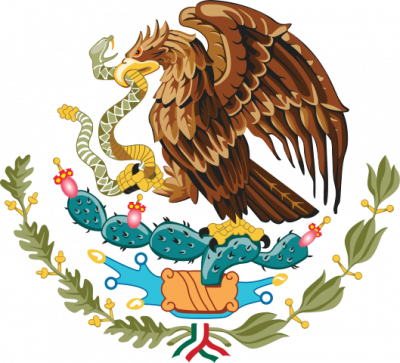The flag of Mexico was adopted on September 16, 1968 and consists of three vertical stripes of green, white and red in the appropriate order, with the coat of arms on the central white stripe.
The flag of Mexico was adopted on September 16, 1968 and consists of three vertical stripes of green, white and red in the appropriate order, with the coat of arms on the central white stripe.

The Mexican coat of arms is an important symbol of the country, the origins of which come from an Aztec legend. The god Huitzilopochtli appeared in a dream to the leader of a nomadic tribe and told him that on his way he would meet an eagle eating a snake sitting on top of a cactus, and ordered him to settle in the area where he would see this vision in reality. The tribe did so, and the city of Tenochtitlan, now called Mexico City, was built on that spot. According to legend, this event took place in 1325, and in 1811 the eagle became a popular seal during the War of Independence and was later added to the flag. Over time, the details of the coat of arms have changed several times, but its basis has remained unchanged. The current coat of arms was designed in 1968 and is a symbol of patriotism. The coat of arms symbolizes many significant things, including the honoring of a legend and the victory of a noble creature over a snake.
The coat of arms of Mexico has a certain symbolism:
The coat of arms was added to the flag in 1968 on the occasion of the country's participation in the Olympic Games, as the flag at that time was very similar to the Italian flag, which was not allowed.
The evolution of the Mexican flag has a rich history that reflects the social and political changes in the country. Before gaining independence from Spain in 1821, the Spanish yellow and red flag was the national flag. The first national flag of Mexico already contained three vertical stripes - green, white and red, but with a royal crown in the center and an eagle perched on a cactus.

After the collapse of the Mexican Empire in 1823, the flag was changed to the flag of the new republic. The royal crown was removed, and the eagle was detailed to reflect the Aztec emblem from the founding of Tenochtitlan.
Several other changes were made during the 19th century, reflecting changes in government and internal conflicts. In 1864, during the short reign of Emperor Maximilian, a crowned eagle appeared in the center of the flag.

In 1916, President Venustiano Carranza defined and standardized the eagle emblem according to the description in the Codex Mendoza, a 16th-century Aztec document. The eagle was to be depicted in profile, with its left wing extended in an attacking gesture, with a snake in its beak and right claw, perched on a cactus.
The modern version of the flag was adopted on September 16, 1968, and approved by the Law on the State Flag and Anthem in 1984.